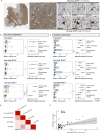Inflammatory microglia correlate with impaired oligodendrocyte maturation in multiple sclerosis
- PMID: 39877374
- PMCID: PMC11772157
- DOI: 10.3389/fimmu.2024.1522381
Inflammatory microglia correlate with impaired oligodendrocyte maturation in multiple sclerosis
Abstract
Introduction: Remyelination of demyelinated axons can occur as an endogenous repair mechanism in multiple sclerosis (MS), but its efficacy varies between both MS individuals and lesions. The molecular and cellular mechanisms that drive remyelination remain poorly understood. Here, we studied the relation between microglia activation and remyelination activity in MS.
Methods: We correlated regenerative (CD163+) and inflammatory (iNOS+) microglia with BCAS1+ oligodendrocytes, subdivided into early-stage (<3 processes) and late-stage (≥3 processes) cells in brain donors with high or low remyelinating potential in remyelinated lesions and active lesions with ramified/amoeboid (non-foamy) or foamy microglia. A cohort of MS donors categorized as efficiently remyelinating donors (ERDs; n=25) or poorly remyelinating donors (PRDs; n=17) was included, based on their proportion of remyelinated lesions at autopsy.
Results and discussion: We hypothesized more CD163+ microglia and BCAS1+ oligodendrocytes in remyelinated and active non-foamy lesions from ERDs and more iNOS+ microglia with fewer BCAS1+ oligodendrocytes in active foamy lesions from PRDs. For CD163+ microglia, however, no differences were observed between MS lesions and MS donor groups. In line with our hypothesis, we found that INOS+ microglia were significantly increased in PRDs compared to ERDs within remyelinated lesions. MS lesions, more late-stage BCAS1+ oligodendrocytes were detected in active lesions with non-foamy or foamy microglia in comparison with remyelinated lesions. Although no differences were found for early-stage BCAS1+ oligodendrocytes between MS lesions, we did find significantly more early-stage BCAS1+ oligodendrocytes in PRDs vs ERDs in remyelinated lesions. Interestingly, a positive correlation was identified between iNOS+ microglia and the presence of early-stage BCAS1+ oligodendrocytes. These findings suggest that impaired maturation of early-stage BCAS1+ oligodendrocytes, encountering inflammatory microglia, may underlie remyelination deficits and unsuccessful lesion repair in MS.
Keywords: inflammation; microglia; multiple sclerosis; oligodendrocytes; remyelination.
Copyright © 2025 Chen, Wever, McNamara, Bourik, Smolders, Hamann and Huitinga.
Conflict of interest statement
The authors declare that the research was conducted in the absence of any commercial or financial relationships that could be construed as a potential conflict of interest. The author(s) declared that they were an editorial board member of Frontiers, at the time of submission. This had no impact on the peer review process and the final decision.
Figures


References
MeSH terms
Substances
LinkOut - more resources
Full Text Sources
Medical
Research Materials

